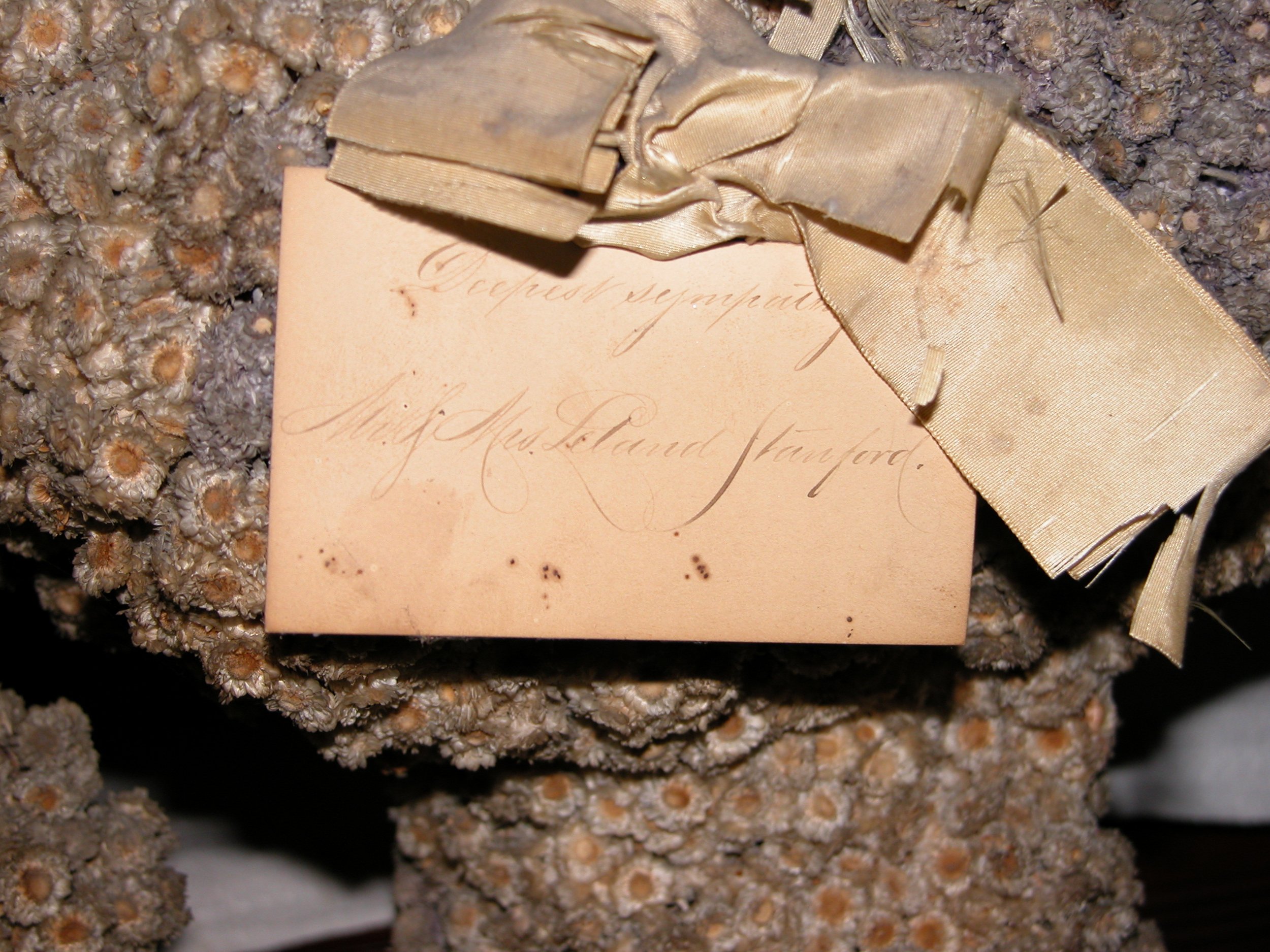19th century view of the floral tributes at Grant Cottage. (Image colorized by Ranger Nick Sacco from U.S. Grant National Historic Site)
One group of artifacts at Grant Cottage Historic Site invariably leaves visitors intrigued and impressed. Some find them “creepy” others “amazing”, but all agree that the funerary floral tributes on display in the Cottage are incredibly unique. The story of these dried sentinels of remembrance begins much farther back in time than when they were produced. Flowers have been a part of burial rituals into the distant past of human history, but it would be the tragic death toll of the American Civil War that ushered in the golden age of floral tributes, artistic symbols of Victorian-era mourning. In the summer of 1885, some exceptional floral tributes arrived on Mt. McGregor for the funeral of Ulysses S. Grant. These 137-year-old floral pieces, which astoundingly remain on display in the cottage parlor, were recently brought into better focus by new discoveries.
In 1885 the floral tributes drew the attention of reporters when they arrived at the small train platform near the cottage on Mt. McGregor. When the first “elaborate floral piece” in the design of a pillow was unboxed “all present uttered exclamations of surprise” and “A photographer made a photograph of it before it was taken to the Grant cottage.” The pillow was a tribute to General Grant from his former soldiers, the Grand Army of the Republic veterans. One reporter noted that “Almost every train which arrived at Mt. McGregor has brought beautiful floral mementos from Grand Army Posts and other organizations, and also from personal friends…”
The original tag on the Gates Ajar funeral tribute at Grant Cottage which reads “Deepest Sympathy Mr. & Mrs. Leland Stanford”.
In the days leading up to Grant’s funeral, the parlor of the Cottage was “fragrant with flowers” from the abundant fresh floral arrangements and decorated with various natural wreaths. In the center of the room rested the catafalque holding Grant’s glass-top casket with the pillow tribute resting on a table behind it as well as a tribute consisting of a heart and anchor flanking a cross. Perhaps the most impressive piece was the enormous six-foot-high “Gates Ajar” tribute which rested in front of the fireplace. The piece, which was likely custom-built, was sent by family friend Leland Stanford of California and was designed to depict the gates of heaven, a popular theme of tributes in that era.
In this 1885 illustration from Frank Leslie’s Illustrated floral tributes are depicted near the casket of U.S. Grant in the parlor of Grant Cottage.
In August 2021 historical florist expert Robert Treadway (co-author of A Centennial History of the American Florist) visited the Historic Site to carefully evaluate the floral wonders. For him, it was a once-in-a-lifetime opportunity to see with his own eyes items he had only read about and viewed in books. Under the supervision of conservators from the New York State Bureau of Historic Sites and site staff, Treadway eagerly inspected the items as if they lay in the freshly opened tomb of an Egyptian pharaoh. It truly was an interesting journey of discovery for all involved as long-hidden secrets came to light.
Historical florist expert Robert Treadway closely examines the floral tributes at Grant Cottage with a conservator from The Bureau of Historic Sites.
A close up of the pillow of rest floral tribute at Grant Cottage.
The two most prominent beliefs about the flowers were that they were prepared using fresh flowers which dried over time and that they were coated in wax to preserve them. Treadway dispelled these notions almost immediately. The most prevalent flowers used in the tributes were immortelles (Helichrysum), also known as everlastings, which were dried before use. The small round blooms were frequently shipped to the United States from Europe and dyed in various colors for use by florists. Bunches of the immortelles would be wired to a small stick and inserted into moss which filled a wire framework to create the tributes. It was a painstaking process that involved numerous assistants. With the flowers only designed for short-term use, wax-coatings were not practical, and Treadway found no evidence of preservation wax on the pieces.
The more intimately the artifacts are examined the more impressive their longevity becomes. Constructed mainly of organic materials they are subject to deterioration due to multiple factors. Damages due to insects, rodents, climate, and even human theft reveal their delicate nature. Preservation knowledge and methods have certainly changed dramatically since the 1880s when human theft by souvenir hunters was noted as the main concern. Weighing the factors threatening the pieces with their interpretation is a sensitive balance that is not taken lightly by those tasked with their care. Conservators and staff discussed various options including coatings, enclosures, and environmental controls each with its benefits and drawbacks.
Flowers are ingrained in human cultures throughout the world as tokens of celebration, love, sympathy, and mourning. In the Victorian era, immortelle flowers symbolized remembrance and hope in everlasting life, especially to the families of the deceased. Funeral set pieces came in a variety of shapes and each of the five pieces on display in the cottage held specific meanings:
Funeral tributes at Grant Cottage featuring various popular symbolism of the era.
A cross and sword floral tribute at Grant Cottage.
The “Gates Ajar” symbolized the gates of heaven, comforting the grieving with the reassurance that their lost loved one is destined for a better place that, with the gate left ajar, they could follow and be reunited. The pillow set piece represented peace, relief, and eternal rest from the trials of the physical world. The text of dyed immortelles on the pillow “Comrade U.S. Grant. From Meade Post No. 1, G.A.R., Phil.” represented the undying admiration of the Civil War veterans for their former commander. Two pieces feature a cross which was one of the most common shapes used in funeral pieces and was symbolic of the Christian tenets of grace, forgiveness, and salvation. Two pieces incorporate the anchor, another favorite Christian symbol representing hope amid trial with God being the “anchor of the soul.” One piece features a heart along with the anchor and cross. The heart symbolized the everlasting love of Christ but also the love of those in mourning for the deceased. The pillow and one of the pieces with a cross also feature a sword. The sword had a direct association with General Grant due to his military career, but also more generally symbolized justice, fortitude, and courage.
An exception to the rule, this anchor tribute at Grant Cottage is made with artificial fabric components coated in wax.
Victorian set pieces showcase the true artistry and creativity of florists during that period. One of the best-known florists Adolph Le Moult, operating out of New York City, created one of the largest floral pieces ever made for an event in Ulysses Grant’s honor at Philadelphia in 1879. Le Moult also created impressively elaborate floral tributes for Grant’s funeral in New York City in 1885. The goal of florists in the 19th century was not just making impressive arrangements but also ensuring they would last. Florists boasted in advertisements with statements such as, “I can so perfectly preserve even the most delicate flowers that they will last forever.”
Preserved floral wreath from Queen Victoria at James Garfield NHS.
Preserved funeral mementos from the Victorian era of varying types reside in public and private collections throughout the world. There is a coated and encased floral wreath from the 1881 funeral of James Garfield on display at his home (James A. Garfield National Historic Site) in Mentor, Ohio. What truly makes the tributes at Grant Cottage unique is the sheer scale of the items. The two largest pieces are larger than any others known, and they all remain in their original state having never been coated or encased. It is undoubtedly this originality that creates the eeriness that many visitors experience upon viewing them.
Flower arrangements were an integral part of a larger umbrella of Victorian-era mourning practices. These relatively costly items were deemed essential and most funerals of the period had at least a few tributes present. For the immediate family of the deceased, some mourning practices lasted years. Two years after her husband’s death Julia Grant, staying at the family’s Long Branch, New Jersey cottage, continued remembering her greatest love through mourning rituals with flowers still playing a pivotal role:
“On an antique cabinet… is a bust in plaster of the brave old soldier… Behind it hangs a wreath of white immortelles -a widow’s first tribute to memory- with a circlet of white ribbon still clinging to it, typical of wedded love. A slender glass filled with geraniums… Every morning this tiny bouquet is gathered… by the lonely wife who kisses the blossoms and tenderly places them before the face of her hero. The faded flowers are dried and, mixed with their own fragrance, go to make those memory-bags so highly prized by the friends on whom they are bestowed.”
Floral arrangements continued to play a role at Grant Cottage in the form of floral wreaths presented at the site during annual memorial ceremonies throughout the 20th century, yet none of these survive. There is a tinge of irony in the fact that most pieces made with flowers symbolizing immortality have been lost to time making the existence of the flowers on display in Grant Cottage a unique anomaly. Grant family members, Civil War veterans, and thousands of others visited Grant Cottage in the 1890s. In 1895 the flowers were described as making a visit to Grant Cottage “more like going to pay respects to a man who dwells there than like visiting… the dying spot of a dead hero.”
The tributes remain an eminently appropriate part of a place that was intentionally preserved in situ to immortalize a moment in time and the legacy of a national hero. For now, these evocative treasures will continue to captivate visitors as they marvel at their very existence. The pieces represent to modern visitors a moment in the evolution of funeral rituals. A rare opportunity to be transported back to a moment when family, friends, and a nation were in mourning for an American icon. They are tributes not only to a man of the past but to the character he displayed and the ideals he lived by. They represent not just a moment in time, but the enduring legacy of humanity’s need to grieve and desire to memorialize those they love and respect.
Floral tributes at Grant’s Tomb in Riverside Park, New York - May 1886.
These, our Earth’s perennial flowers—
The fadeless blooms by Poets sung,
Songs, that from Homer’s Age till ours,
Down the aisles of Time have rung—
In many an emblem do we weave
For passionate Remembrance’ sake;
And howe’er we joy, howe’er we grieve,
Sacred pilgrimages make;
For Loss and Grief, the Asphodels
On our graves we mourning lay;
For Memory, the Immortelles—
Our loved ones live for us always.
Death in Life, Life in Death—how we
This, Love’s Faith, keep reverently.
By Laura G. Collins’s from Immortelles and Asphodels (Everlastings) (1898)
Sources:
-The Centennial History of the American Florist
-He Died Ten Years Ago from The Morning Times [Washington, D.C.], 8/4/1895
-The Grants at Long Branch from The Indianapolis Journal, 8/10/1887
-Immortelles: Literary, Botanical, and National Memories by Kara Marler-Kennedy from Erudit (2009)
-The Sun [New York, NY], 7/29/1885
-The Holt County Sentinel [Oregon, MO], 7/31/1885
-The Rock Island Argus [Rock Island, IL], 7/31/1885
-The Largest Bouquet in the World from The Dansville Daily Advertiser [Dansville, NY] 10/2/1879
-Framing Grief: Funeral Flower Frames in America, 1860-1920 by Janie Rawles Askew
-Death in the Presidential Collections, blog posts 1-6, National Museum of American History (2017)













